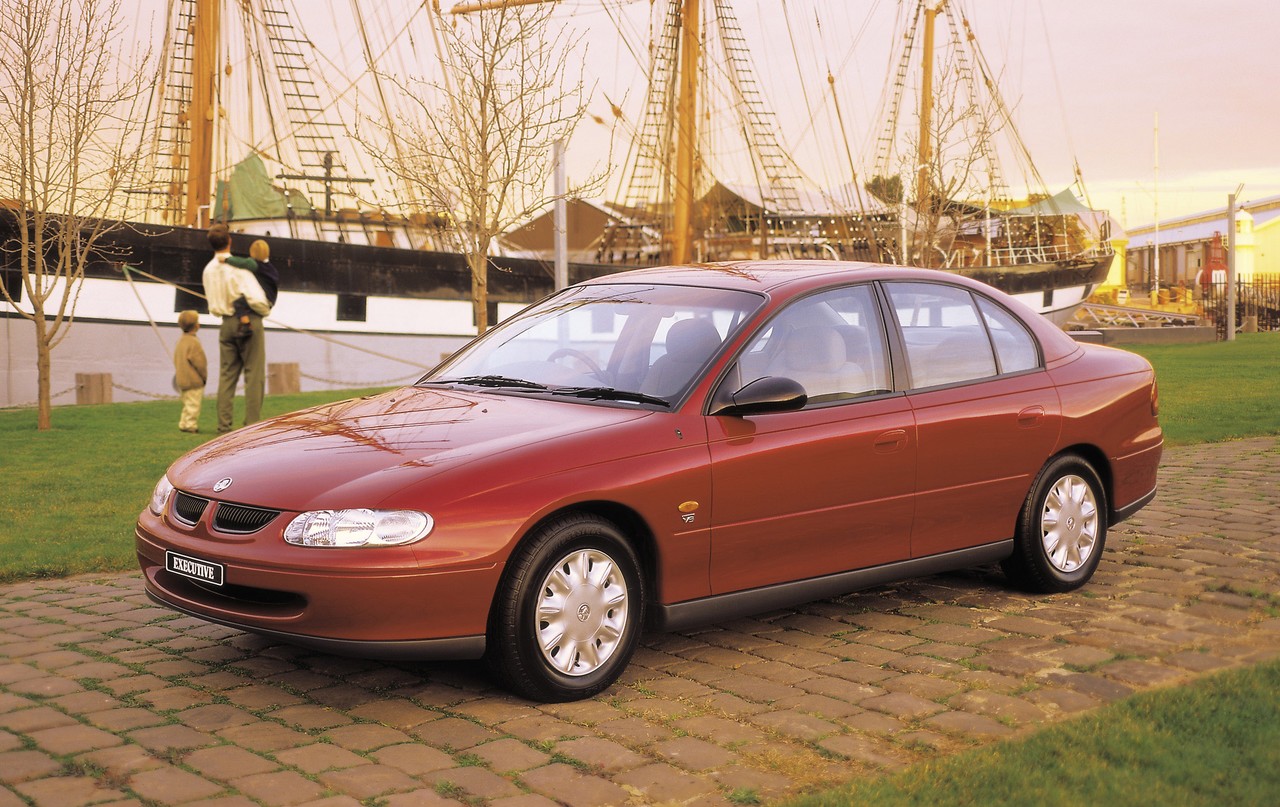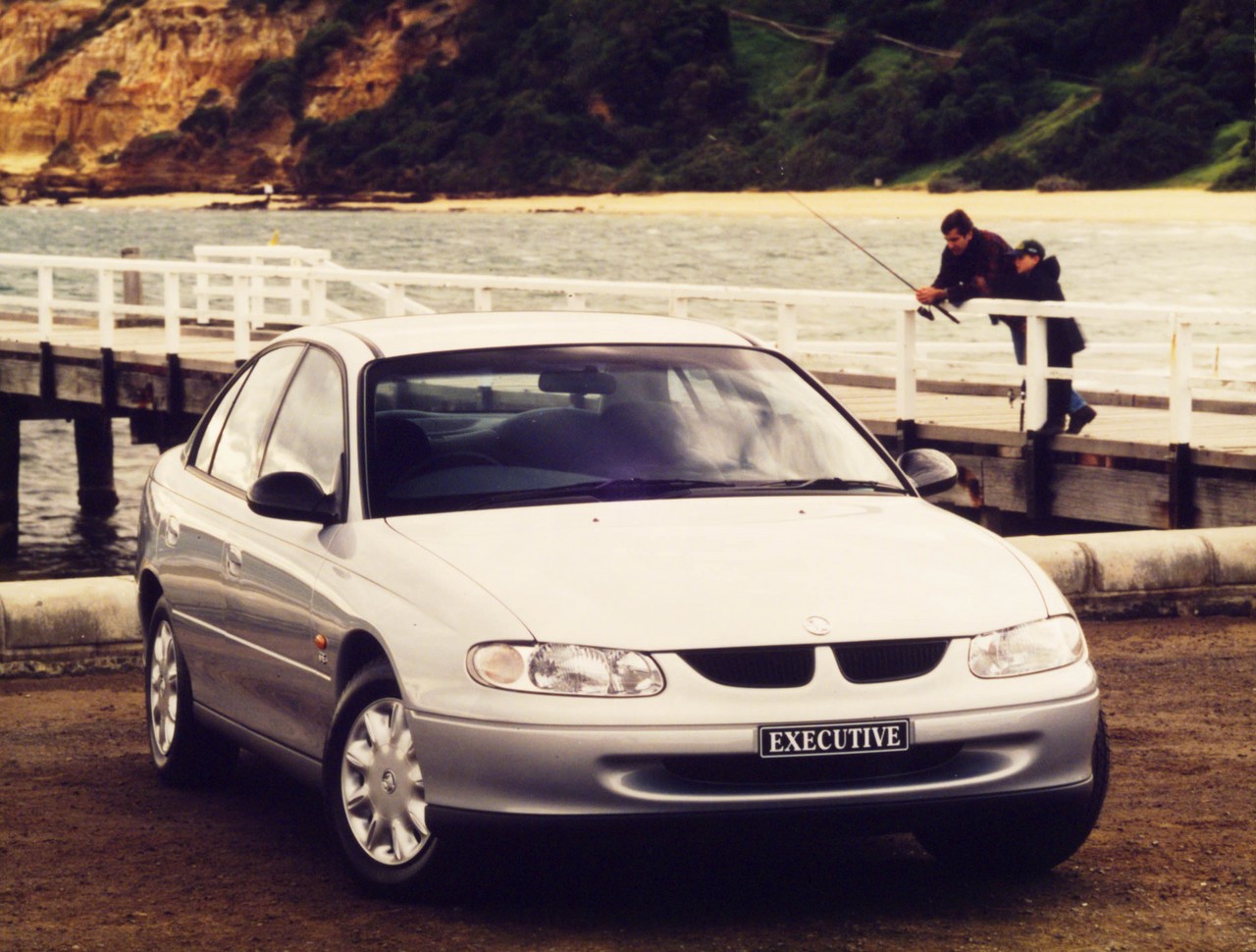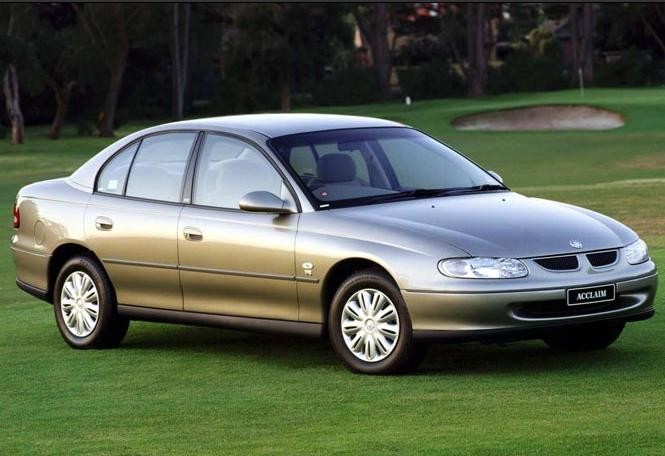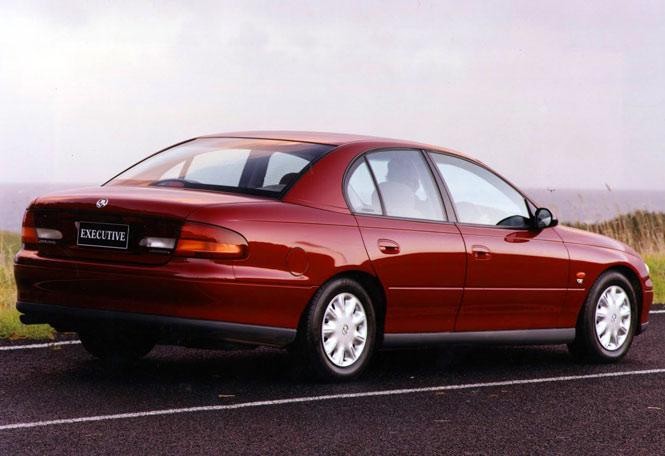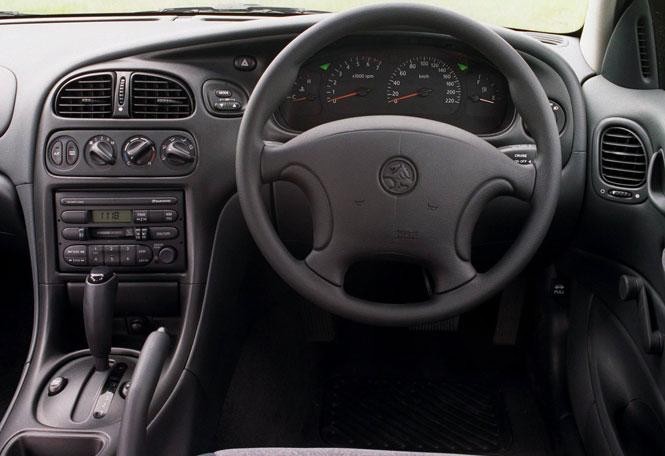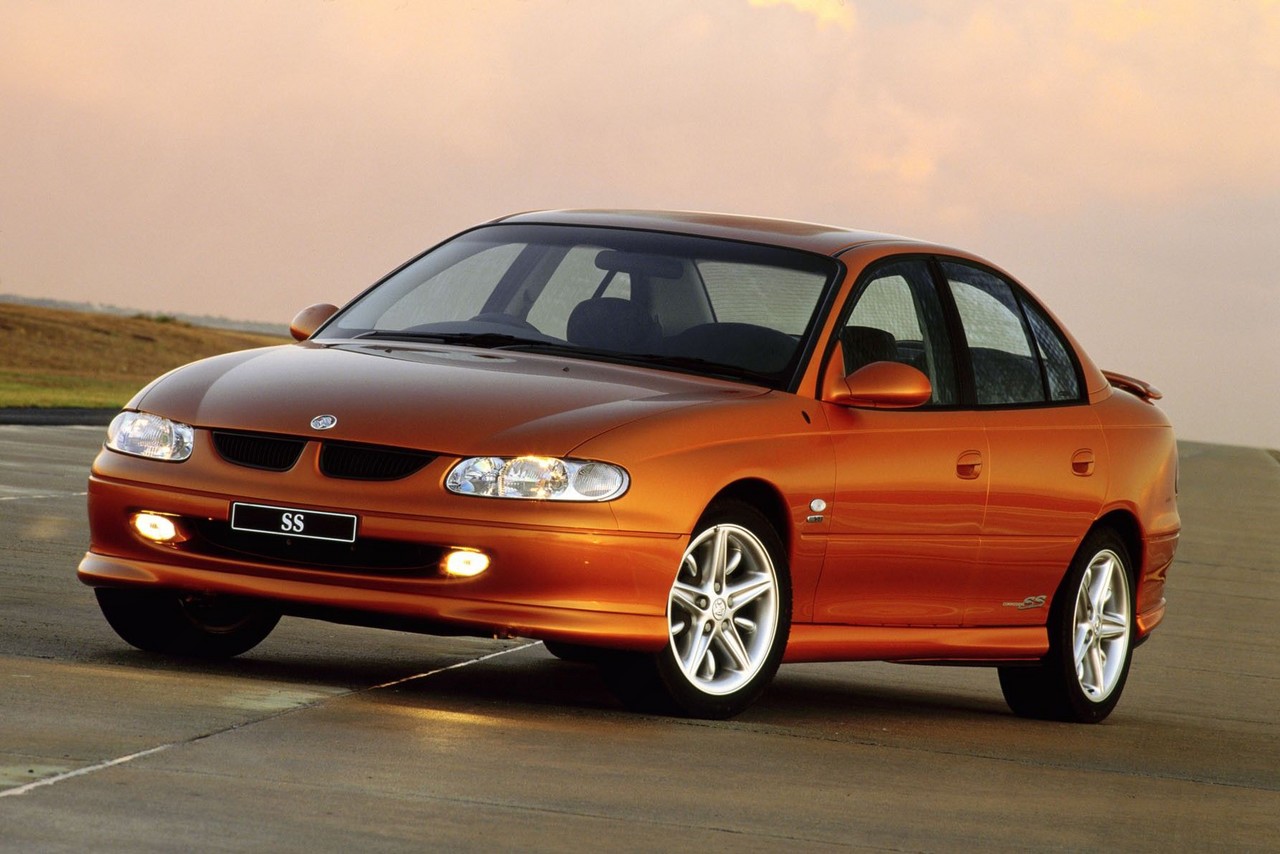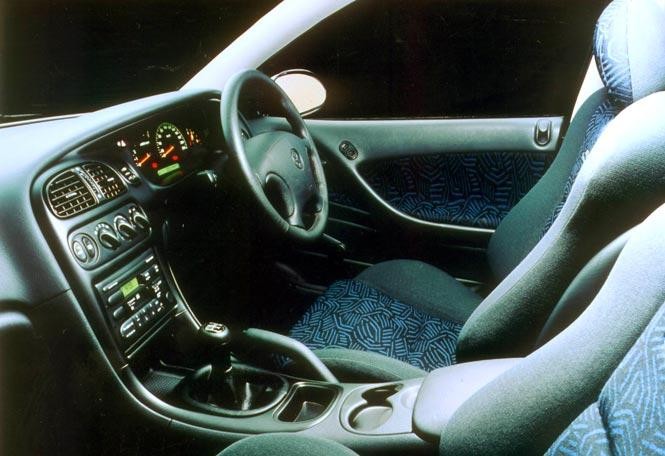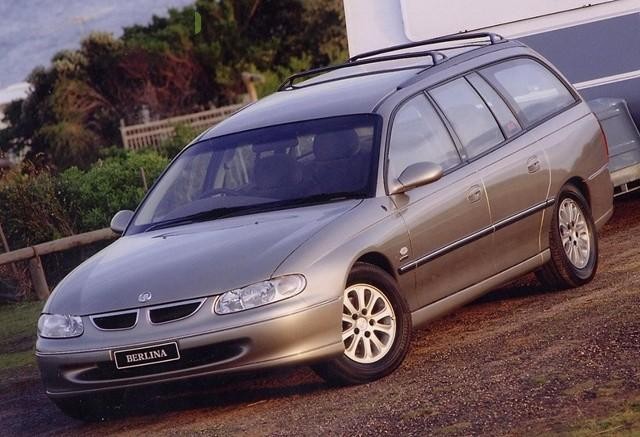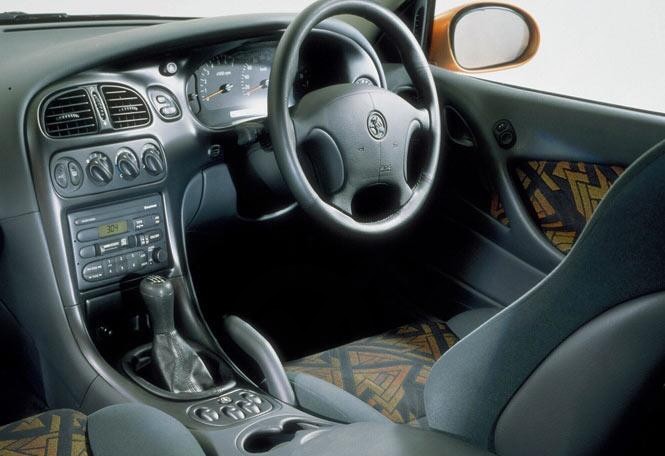
- Economical 3.8-litre L36 V6 engine
- Spacious and comfortable interior
- Accomplished ride/handling balance
- Quiet, well-insulated cabin
- V6 engine coarse above 3000 rpm
- Clunky downshifts for automatic transmission
- Vague steering lacks feel
- Low standard of interior fit and finish
- Poor build quality for 5.7-litre LS1 V8 engine
- No toe control links for rear suspension (introduced in VX.II Commodore)
Holden VT.I Commodore (1997-99)
Overview
Released in August 1997, the Holden VT Series I (VT.I) Commodore was available as a large sedan or wagon. Manufactured in Elizabeth, South Australia, the rear-wheel drive VT Commodore was initially available with 3.8-litre V6, supercharged 3.8-litre V6 and 5.0-litre V8 engines. As per the table below, the VT.I Commodore range consisted of Executive, Acclaim, Berlina, S and SS variants.
Engines: V6, Supercharged V6 and V8
Of the engines,
- The 3.8-litre L36 pushrod V6 petrol engine had a cast iron block and cylinder head, multi-port fuel injection, two valves per cylinder, a single balance shaft and a compression ratio of 9.4:1. For the VT range, the L36 engine was fitted with an updated injection fuel system to reduce emissions;
- The 3.8-litre L67 supercharged V6 engine was based on the L36 engine but distinguished by its Eaton M90 supercharger (which provided boost pressure of 6 psi or 0.41 bar), fuel injectors, cylinder heads and lower intake manifold; the compression ratio was also lowered to 8.5:1; and,
- The 5.0-litre LB9 pushrod V8 engine had a cast iron block, two valves per cylinder, multi-point fuel injection and a compression ratio of 8.4:1. To comply with new emissions standards, changes for the VT generation were made to the cylinder heads, pistons, camshaft, throttle body, air intake and exhaust systems.
Transmissions: 4L60E, M35 and M34
All engines were available with four-speed 4L60E automatic transmissions; models with V6 engines were available with M35 Getrag (‘Getrag 260’) manual transmissions, while models with V8 engines were available with M34 Getrag (‘Getrag 290’) manual transmissions.
Engines and transmissions
The product of a $600 million development program, the VT Commodore was based on an extended and strengthened GM2800 platform which also underpinned the Opel Omega B. Compared to the VS Commodore , the VT Commodore sedan was 23 mm longer (at 4884 mm), 48 mm wider (1842 mm), 47 mm taller (1450 mm) and had a 57 mm longer wheelbase (2788 mm). Compared to the VT sedan, the wagon models were 158 mm longer (at 5042), 5 mm wider (1847 mm), 95 mm taller (1545 mm) and had a 150 mm longer wheelbase (2938 mm).
Suspension
The VT Commodore had MacPherson strut front suspension and, for the first time, semi-trailing arm independent rear suspension (albeit without toe control links) was standard across the range.
| Body | Variant | Engine | Trans. | Peak power | Peak torque |
|---|---|---|---|---|---|
| Sedan, wagon | Executive | 3.8-litre L36 petrol V6 | 4sp auto, 5sp man. |
147 kW at 5200 rpm | 304 Nm at 3600 rpm |
| 5.0-litre petrol V8 | 4sp auto, 5sp man. |
179 kW at 4800 rpm | 400 Nm at 3600 rpm | ||
| Acclaim | 3.8-litre L36 petrol V6 | 4sp auto | 147 kW at 5200 rpm | 304 Nm at 3600 rpm | |
| Berlina | 3.8-litre L36 petrol V6 | 4sp auto | 147 kW at 5200 rpm | 304 Nm at 3600 rpm | |
| 5.0-litre petrol V8 | 4sp auto | 179 kW at 4800 rpm | 400 Nm at 3600 rpm | ||
| Sedan only |
S | 3.8-litre L36 petrol V6 | 4sp auto, 5sp man. |
147 kW at 5200 rpm | 304 Nm at 3600 rpm |
| 3.8-litre L67 s/charged petrol V6 | 4sp auto | 171 kW at 5200 rpm | 375 Nm at 3000 rpm | ||
| SS | 3.8-litre L67 s/charged petrol V6 | 4sp auto | 171 kW at 5200 rpm | 375 Nm at 3000 rpm | |
| 5.0-litre petrol V8 | 4sp auto, 5sp man. |
179 kW at 4800 rpm | 400 Nm at 3600 rpm |
Safety equipment
Standard safety for the Commodore Executive and S included a driver’s airbag, front seatbelt pretensioners and anti-submarining seat ramps. The Berlina and SS were further equipped with a front passenger airbag and ABS, while the Acclaim was also fitted with traction control.
Brakes
The VT Commodore had 296 mm by 28 mm vented front brake discs with twin-piston calipers and 286 mm by 16 mm solid rear brake discs with single piston calipers.
Features: Commodore Executive, Acclaim and Berlina
Standard features for the Commodore Executive included 15-inch steel wheels, a six speaker sound system with radio and cassette player, power adjustable driver’s seat, remote central locking, power mirrors, trip computer and immobiliser. Wagon models were fitted with five seats as standard, but two additional rear seats – suitable for children under the age of 12 – could be optioned.
The Commodore Acclaim added cruise control, while the Berlina was further equipped with 15-inch alloy wheels, climate control air conditioning, power windows, power antenna and alarm.
Features: Commodore S and SS
Compared to Executive, the Commodore S added 16-inch alloy wheels with FE2 sports suspension, air conditioning, a leather-wrapped steering wheel and body kit (including a rear spoiler); automatic models were also fitted with cruise control.
Relative to the S variant, the Commodore SS was distinguished by its 17-inch alloy wheels (with FE2 sports suspension), limited slip differential, contoured sports seats and front fog lights.
1998 Commodore 50th Anniversary
In June 1998, a limited-run 50th Anniversary variant was released to commemorate 50 years since the release of the first Holden in Australia. Based on the Executive, the 50th Anniversary was further equipped with 15-inch alloy wheels, a CD player, air conditioning, cruise control, power antenna, chrome exhaust tip and chrome body side mouldings; wagon models were also fitted with roof racks.
1999 Commodore Equipe
In March 1999, a limited-run Equipe variant was released. Based on the Executive, the Equipe added 16-inch alloy wheels, a CD player, air conditioning, cruise control, power windows and power antenna.
Holden VT.II Commodore (1999-00)
Overview
Released in June 1999, the VT Series II (VT.II) Commodore introduced a revised range, improved equipment levels and a new V8 engine, with the 5.0-litre V8 replaced by the Chevrolet-sourced 5.7-litre ‘Generation III’ or LS1 V8 engine (detailed below).
Visually, the VT.II Commodore could be identified by its revised grille treatments in matt silver and chrome, clear side and rear indicator lenses, chrome window surrounds, new wheel covers and alloy wheel designs and ‘Series II’ badges. Inside, there were new cloth seating trims for each variant.
5.7-litre LS1 V8 engine
The 5.7-litre LS1 pushrod V8 engine had all-aluminium construction, a 99 mm bore, 92 mm stroke, sequential multi-port fuel injection, flat-topped pistons, two valves per cylinder, twin knock control sensors, a compression ratio of 10.1:1 and a 6000 rpm redline. Furthermore, the LS1’s aluminium cylinder block assembly weighed 48.85 kg, resulting in a 40 kg weight saving relative to its 5.0-litre, cast-iron predecessor.
Transmission options for the LS1 engine consisted of four-speed 4L60E automatic and six-speed Tremec T56 manual transmissions.
| Body | Variant | Engine | Trans. | Peak power | Peak torque |
|---|---|---|---|---|---|
| Sedan, wagon | Executive | 3.8-litre L36 petrol V6 | 4sp auto, 5sp man. |
147 kW at 5200 rpm | 304 Nm at 3600 rpm |
| 5.7-litre LS1 petrol V8 | 4sp auto, 6sp man. |
220 kW at 5000 rpm | 446 Nm at 4400 rpm | ||
| Acclaim | 3.8-litre L36 petrol V6 | 4sp auto | 147 kW at 5200 rpm | 304 Nm at 3600 rpm | |
| Berlina | 3.8-litre L36 petrol V6 | 4sp auto | 147 kW at 5200 rpm | 304 Nm at 3600 rpm | |
| 5.7-litre LS1 petrol V8 | 4sp auto | 220 kW at 5000 rpm | 446 Nm at 4400 rpm | ||
| Sedan only |
Berlina | 3.8-litre L67 s/charged petrol V6 | 4sp auto | 171 kW at 5200 rpm | 375 Nm at 3000 rpm |
| S | 3.8-litre L36 petrol V6 | 4sp auto, 5sp man. |
147 kW at 5200 rpm | 304 Nm at 3600 rpm | |
| 3.8-litre L67 s/charged petrol V6 | 4sp auto | 171 kW at 5200 rpm | 375 Nm at 3000 rpm | ||
| SS | 5.7-litre LS1 petrol V8 | 4sp auto, 6sp man. |
220 kW at 5000 rpm | 446 Nm at 4400 rpm |
Safety equipment
Compared to their VT.I predecessors, safety equipment for the VT.II Berlina and Acclaim variants was extended to include front seat-mounted side airbags with thorax and head protection (and optional for other variants). The SS was also fitted with switchable traction control for automatic models.
Features
Standard features for the Holden VT.II Commodore were improved with the introduction of remote central deadlocking, a disabling function for the power-operated boot release, a ‘key off’ courtesy lamp and ‘battery saver’ function which automatically shut down any lights after 60 minutes of inactivity.
The Acclaim received air conditioning, while the Berlina gained textured plush velour seats, remote approach lighting (activated by pressing ‘unlock’ on the key fob), a transmission indicator display in the instrument panel and a ‘woodgrain style’ transmission surround.
The S and SS were fitted with cruise control for manuals (previously limited to automatic models), four power-operated windows and were available with a choice of three distinctive fabric trims that were coordinated with the exterior paint finishes.
1999 Commodore Olympic Edition
In September 1999, a limited-run Olympic Edition was released. Based on the Executive, the Olympic Edition added 15-inch alloy wheels, a CD player, air conditioning, cruise control, power windows, a power antenna, chrome exhaust tip and body side mouldings with chrome inserts; wagon models were also fitted with roof racks.
Related links
